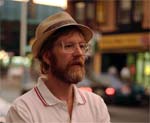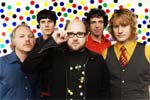| |
|
|
|
|
|
|
| |

$31.99 CDx4


$24.99 MP3


|
|
GAS
Nah Und Fern
(Kompakt)
 "Konigsforst" "Konigsforst"
 "Pop" "Pop"
Of his many projects, Kompakt co-originator Wolfgang Voigt has described Gas as his most personal, having been inspired by “mind walks” in the forest. He imagined a “gaseous and nebulous sound of an exhilarating streaming music which literally flows over, which has no beginning or end, no hard edges, only softness.” In an interview, Voigt once described Gas as “the sound of an old man wandering through the forest on acid.” It is exactly the type of project that is much easier to experience than describe.
For those of us who aren’t old men tripping in the woods, I offer the following description: Gas is essentially an amorphous, moving, multi-layered cloud of sound set at varying emotional temperatures, often softly anchored with a muffled, heartbeat like pulse. The palette and placement of sounds are what really set Gas apart from other techno or ambient projects. What at first seems imbalanced and without any focus transforms into a vividly real, beautiful and vast space.
As a kid or otherwise, who hasn’t been mesmerized during a night drive down the highway, looking out a dew-covered windshield with the lights in the distance, the rhythmic, almost subliminal drone of the tires on the wet pavement and the gently random rhythm of the rain hitting the glass, all miraculously synchronized with the dull, monotonous, heartbeat-like thud of the windshield wipers? (BTW: That’s one of my main realizations upon revisiting these classic albums -- how the bass drum has such a similar texture to the comforting, dull, muffled thud of a windshield wiper!) Now imagine that with Cocteau Twins and your favorite ambient drone record playing simultaneously on the stereo loudly but with a wet towel over the speakers. That’s Gas.
Or go back to the first time you heard My Bloody Valentine's “To Here Knows When.” Remember how at first it sounded like there was a serious mistake made somewhere between the recording process and the manufacturing plant, where either all of the levels were yanked out of place before recording or someone spilled a milkshake on the plates the moment before the pressing occurred? Admit it, you were like “WTF?" But also remember that despite your initial confused reaction, once you got comfortable with it you realized you just discovered a new type of a beautiful thing? That's Gas too!
This four-disc deluxe reissue set is housed in a nice box with some printed cards showing Voigt's colored forest images. The main difference that Voigt and Jorg Burger’s (Modernist) re-mastering has made is the higher strength/definition of the bass kick. It ever-so-slightly lessened the mystery of these recordings but the beauty and uniqueness remains intact. (Voigt himself mentioned that he didn't want to tamper with the recording much since raising the levels tended to reveal its flaws more than its qualities.)
Just so you know, on each release, the atmosphere subtly shifted and tended to correspond to the color of the cover, particularly on the last three albums. For instance, Zauberberg was red and had an ominous twilight to nightfall sound. Konigsforst was golden and had a sun-drenched morning to afternoon sound. Pop’s artwork was more or less a full-color, pine-needle-through-a-kaleidoscope cover, the music within containing the light scent and sound of a moist, sun-dappled pine forest. If in doubt where to begin listening, start with either Konigsforst, the one that most directly integrated beauty and the beat and is also my favorite, or Pop, which achieved the strongest visual quality. (Right away the latter kicks off with the sound of a forest teeming with life; dew dripping from the ripest leaves and animals slithering through the underbrush coincide with the mandibles of insect swarms.)
So anyway, the whole shebang comes more than recommended. Much has been said already about these, until now, criminally out-of-print albums. I hope this review does them justice. [SM] |
|
| |
|
|
|
|
|
|
|






























